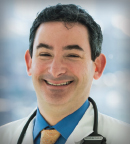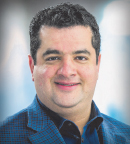Which is the preferred second-line treatment option for patients with relapsed or refractory diffuse large B-cell lymphoma (DLBCL): high-dose chemotherapy and autologous stem cell transplantation (ASCT) or chimeric antigen receptor (CAR) T-cell therapy? This was the subject of a debate at the recent 2022 National Comprehensive Cancer Network (NCCN) Annual Congress: Hematologic Malignancies between Jeremy S. Abramson, MD, taking the position that CAR T-cell therapy is often the better choice, and Mazyar Shadman, MD, MPH, speaking in favor of high-dose chemotherapy plus ASCT.1 Dr. Abramson is Director of the Lymphoma Program and the Jon and Jo Ann Hagler Center for Lymphoma at Massachusetts General Hospital Cancer Center, Boston, and Dr. Shadman is Attending Physician in Hematologic Malignancies and a stem cell transplant expert at the Fred Hutchinson Cancer Center, Seattle.
Of note, the two experts did have some areas of agreement. First, CAR T-cell therapy was the preferred second-line treatment of patients with primary refractory or early relapsed disease. Second, high-dose chemotherapy plus ASCT is an appropriate option for selected patients.

Jeremy S. Abramson, MD

Mazyar Shadman, MD, MPH
Case for CAR T-Cell Therapy in Second-Line Setting
“In the modern era, high-dose chemotherapy plus ASCT eradicates disease in just a minority of patients with relapsed or refractory DLBCL, and only 50% of relapsed patients are candidates for this therapy. For patients with chemotherapy-sensitive disease who relapse within 1 year, high-dose chemotherapy followed by ASCT is a lousy standard of care,” Dr. Abramson told the audience.
Both the ZUMA-7 and the TRANSFORM phase III trials showed the superiority of a CAR T-cell product over the standard of care (ie, high-dose chemotherapy plus ASCT) in the relapsed or refractory setting.2,3 ZUMA-7 included 359 transplant-eligible patients with DLBCL treated with second-line therapy: 74% were primary refractory and 26% were early relapsed. They were randomly assigned 1:1 to receive axicabtagene ciloleucel vs the standard of care (conditioning therapy with cisplatin-based chemoimmunotherapy). No crossover was allowed.
At a median follow-up of 25 months, objective response rates were 83% with CAR T-cell therapy vs 50% for the standard of care. Complete response rates were 65% vs 32%, respectively, and overall survival was not reached vs 35.1 months, trending in favor of axicabtagene ciloleucel.
The rate of cytokine-release syndrome with axicabtagene ciloleucel was 92%, and 60% had neurologic toxicity. The rate of serious cytokine-release syndrome was 6%, and 20% had serious neurotoxicity.
The TRANSFORM trial evaluated lisocabtagene maraleucel vs the standard of care in the second-line setting, with a total of 184 patients with relapsed or refractory DLBCL. About 75% were primary refractory, and 25% were early relapse. Crossover to lisocabtagene maraleucel was allowed for nonresponders to the standard of care. The T-cell product was banked before study treatment was initiated for patients given the standard of care.
A preplanned interim analysis found that about two-thirds of those treated with lisocabtagene maraleucel were in complete response vs 39% on the standard of care. Both event-free survival and progression-free survival significantly favored lisocabtagene maraleucel, reducing the risk of treatment failure, death, or need for new cancer therapy by 65% compared with the standard of care.
The toxicity profile of lisocabtagene maraleucel was more favorable than that of axicabtagene ciloleucel, with 49% having cytokine-release syndrome (one patient was grade 3) and low rates of neurotoxicity (4% had serious neurotoxicity).
A total of 50 patients crossed over to receive lisocabtagene maraleucel as a third-line treatment after failing to respond to the standard of care (80% prior to getting to ASCT and 20% after ASCT). Median time to crossover was 15 days. “The efficacy [of CAR-T] was not quite as favorable as those treated with CAR-T on the lisocabtagene maraleucel arm. This suggests that getting CAR-T as second-line therapy appears better than as third-line therapy.”
Although CAR-T is expensive and has a complex manufacturing process, it cures more patients in the second-line setting than the standard of care.— Jeremy S. Abramson, MD
Tweet this quote
“Although CAR-T is expensive and has a complex manufacturing process, it cures more patients in the second-line setting than the standard of care. CAR-T simply works better,” Dr. Abramson stated. “Why expose 100% of patients to the toxicities of high-dose chemotherapy when about 85% will have only toxicity and no benefit after failing to respond to the standard of care?”
Another argument for CAR T-cell therapy in the second-line setting is that patients and their T cells will be impacted by the chemotherapy after failing to respond to second-line high-dose chemotherapy and so may produce T cells that are less fit for CAR T-cell therapy.
“The trends in improved survival in both ZUMA-7 and TRANSFORM despite having CAR-T cells as a third-line therapy for standard-of-care patients highlight the peril of delaying the best proven treatment for these patients,” Dr. Abramson added.
Case for High-Dose Chemotherapy Plus ASCT
“ASCT became one of the curative options for DLBCL many years ago,” Dr. Shadman said. “Cure is the goal, and we need a strong reason to give up on a curative treatment. We may not have to ‘pick a winner’ for all patients between high-dose chemotherapy plus ASCT vs CAR-T. Sequencing may keep both options viable for selected patients.”
Dr. Shadman agreed with Dr. Abramson that for high-risk patients who relapse within the first 12 months, CAR T-cell therapy should be the standard of care. However, he contended that in real-world practice, it is unlikely for those patients to have immediate access to CAR-T and many physicians start chemotherapy in parallel to starting the process for CAR-T. ASCT should remain an option for second-line therapy for patients who end up receiving second-line chemotherapy while waiting for CAR-T and show a complete or partial response.
A recent article by Dr. Shadman and colleagues found that outcomes with ASCT looked a little better than CAR T-cell therapy in patients in partial response to most recent chemotherapy before either ASCT or CAR-T.4 “The most conservative conclusion is that there is no clear indication that CAR-T is an absolute winner in this setting,” he noted.
“Do we have to pick a winner? We can use CAR-T after high-dose chemotherapy plus ASCT for progressive disease. It is difficult to consider ASCT after CAR-T for progressive disease,” Dr. Shadman commented.
“In summary, patients with primary refractory DLBCL meeting criteria for the ZUMA-7 or TRANSFORM study should receive CAR-T therapy. In real-world practice, many patients receive bridging chemotherapy and achieve a partial or complete response, and high-dose chemotherapy plus ASCT can be considered for such patients,” Dr. Shadman stated.
Access to CAR T-Cell Therapy
During the discussion following the debate, moderator Andrew D. Zelenetz, MD, PhD, of Memorial Sloan Kettering Cancer Center, New York, pointed out that CAR T-cell therapy is available only at specialized centers. “In a flyover map, there is a vast emptiness between coasts except for Chicago, Nebraska, and Texas.”

Andrew D. Zelenetz, MD, PhD
“Economic access is an enormous issue. Black and Hispanic patients are not getting CAR-T therapy, and the statistics for access are even more dismal for these patients compared with their access to conventional chemotherapy,” Dr. Zelenetz told listeners.
“There is no question that access is one of the biggest challenges we face. The answer is to bring CAR-T closer to where people live. There is no reason it has to be done only at academic centers,” agreed Dr. Abramson. “Axicabtagene ciloleucel is the most toxic of the CAR-T products, so it may be less practical to administer at regional centers than lisocabtagene maraleucel or tisagenlecleucel, which have lower rates of toxicity,” he added.
Dr. Abramson continued: “These treatments are very expensive. Payment is another problem. There is little impetus for hospitals to give a therapy that will make them lose money. A safer product like lisocabtagene maraleucel or tisagenlecleucel can be given in an outpatient setting, and the hospital will then get paid for the product. Using safer products will help and admitting only patients with serious side effects will as well. This requires a lot of training and infrastructure.”
DISCLOSURE: Dr. Abramson has served as a consultant for AbbVie, BMS, Genentech, Genmab, Janssen, Kite Pharma, Lilly, MorphoSys, and Regeneron. Dr. Shadman has received grant/research support from AbbVie, Acerta Pharma, AstraZeneca, BeiGene, Celgene, Genentech, Gilead Sciences, Merck & Co, Mustang Bio, Pharmacyclics, Sunesis Pharmaceuticals, and TG Therapeutics; is a scientific advisor for AstraZeneca, AbbVie, ADC Therapeutics, AstraZeneca, Atara Biotherapeutics, Cellectar Biosciences, Genentech, Pharmacyclics, Sound Biologics, and Verastem. Dr. Zelenetz has reported financial relationships with AbbVie, ADC Therapeutics, Biotechnologies Corp, Arvinas, AstraZeneca, BeiGene, Bristol Myers Squibb, Curio Science, Dava Oncology, Genentech, Instituto de Ciencias Integradas, Kyowa Kirin, MEI Pharma, Medscape, Oncopeptides AB, Sandoz, Secura Bio, Suzhou Liang Yihui Network Science, and Technology Company, Limited.
REFERENCES
1. Abramson J, Shadman M: Debate: Transplant vs. CAR T-cell therapy in relapsed/refractory diffuse large B-cell lymphoma. 2022 NCCN Annual Congress: Hematologic Malignancies. Presented October 14, 2022.
2. Locke FL, Miklos DB, Jacobson CA, et al: Axicabtagene ciloleucel as second-line therapy for large B-cell lymphoma. N Engl J Med 386:640-654, 2022.
3. Kamdar M, Solomon SR, Arnason JE, et al: Lisocabtagene maraleucel, a CD19-directed chimeric antigen receptor T cell therapy, versus standard of care with salvage chemotherapy followed by autologous stem cell transplantation as second-line treatment in patients with relapsed or refractory large B-cell lymphoma: Results from the randomized phase 3 TRANSFORM study. 2021 ASH Annual Meeting & Exposition. Abstract 91. Presented December 11, 2021.
4. Shadman M, Pasquini M, Ahn KW, et al: Autologous transplant vs chimeric antigen receptor T-cell therapy for relapsed DLBCL in partial remission. Blood 139:1330-1339, 2022.

